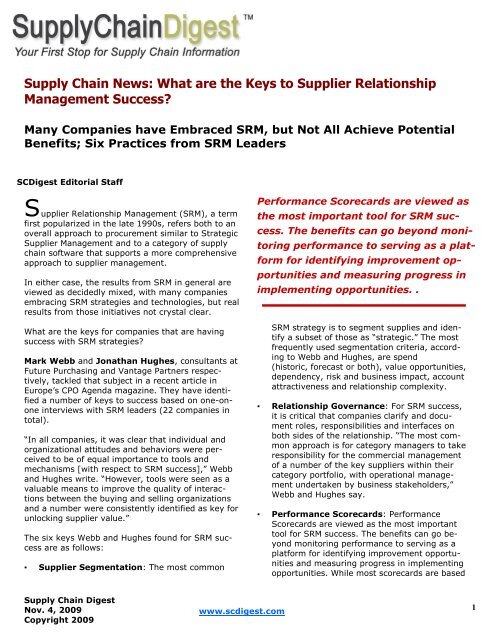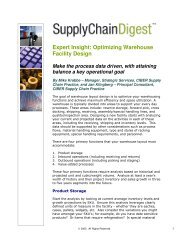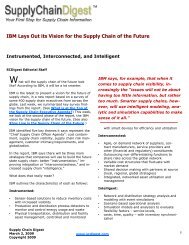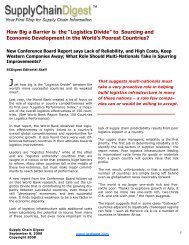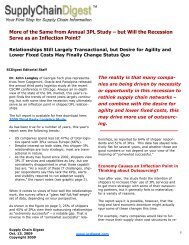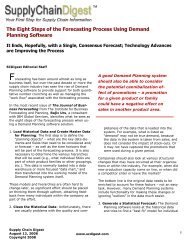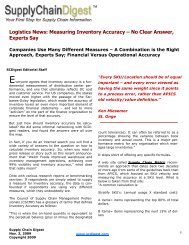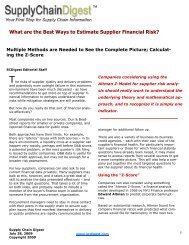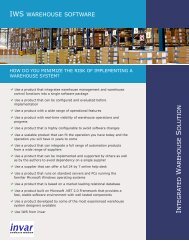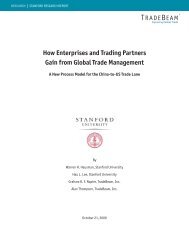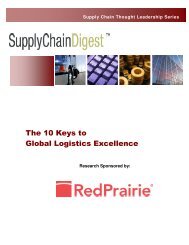What are the Keys to Supplier Relationship Management Success?
What are the Keys to Supplier Relationship Management Success?
What are the Keys to Supplier Relationship Management Success?
Create successful ePaper yourself
Turn your PDF publications into a flip-book with our unique Google optimized e-Paper software.
Supply Chain News: <strong>What</strong> <strong>are</strong> <strong>the</strong> <strong>Keys</strong> <strong>to</strong> <strong>Supplier</strong> <strong>Relationship</strong><br />
<strong>Management</strong> <strong>Success</strong>?<br />
Many Companies have Embraced SRM, but Not All Achieve Potential<br />
Benefits; Six Practices from SRM Leaders<br />
SCDigest Edi<strong>to</strong>rial Staff<br />
S upplier <strong>Relationship</strong> <strong>Management</strong> (SRM), a term<br />
first popularized in <strong>the</strong> late 1990s, refers both <strong>to</strong> an<br />
overall approach <strong>to</strong> procurement similar <strong>to</strong> Strategic<br />
<strong>Supplier</strong> <strong>Management</strong> and <strong>to</strong> a category of supply<br />
chain softw<strong>are</strong> that supports a more comprehensive<br />
approach <strong>to</strong> supplier management.<br />
In ei<strong>the</strong>r case, <strong>the</strong> results from SRM in general <strong>are</strong><br />
viewed as decidedly mixed, with many companies<br />
embracing SRM strategies and technologies, but real<br />
results from those initiatives not crystal clear.<br />
Performance Scorecards <strong>are</strong> viewed as<br />
<strong>the</strong> most important <strong>to</strong>ol for SRM success.<br />
The benefits can go beyond moni<strong>to</strong>ring<br />
performance <strong>to</strong> serving as a platform<br />
for identifying improvement opportunities<br />
and measuring progress in<br />
implementing opportunities. .<br />
<strong>What</strong> <strong>are</strong> <strong>the</strong> keys for companies that <strong>are</strong> having<br />
success with SRM strategies?<br />
Mark Webb and Jonathan Hughes, consultants at<br />
Future Purchasing and Vantage Partners respectively,<br />
tackled that subject in a recent article in<br />
Europe’s CPO Agenda magazine. They have identified<br />
a number of keys <strong>to</strong> success based on one-onone<br />
interviews with SRM leaders (22 companies in<br />
<strong>to</strong>tal).<br />
“In all companies, it was clear that individual and<br />
organizational attitudes and behaviors were perceived<br />
<strong>to</strong> be of equal importance <strong>to</strong> <strong>to</strong>ols and<br />
mechanisms [with respect <strong>to</strong> SRM success],” Webb<br />
and Hughes write. “However, <strong>to</strong>ols were seen as a<br />
valuable means <strong>to</strong> improve <strong>the</strong> quality of interactions<br />
between <strong>the</strong> buying and selling organizations<br />
and a number were consistently identified as key for<br />
unlocking supplier value.”<br />
The six keys Webb and Hughes found for SRM success<br />
<strong>are</strong> as follows:<br />
▪<br />
<strong>Supplier</strong> Segmentation: The most common<br />
▪<br />
▪<br />
SRM strategy is <strong>to</strong> segment supplies and identify<br />
a subset of those as “strategic.” The most<br />
frequently used segmentation criteria, according<br />
<strong>to</strong> Webb and Hughes, <strong>are</strong> spend<br />
(his<strong>to</strong>ric, forecast or both), value opportunities,<br />
dependency, risk and business impact, account<br />
attractiveness and relationship complexity.<br />
<strong>Relationship</strong> Governance: For SRM success,<br />
it is critical that companies clarify and document<br />
roles, responsibilities and interfaces on<br />
both sides of <strong>the</strong> relationship. “The most common<br />
approach is for category managers <strong>to</strong> take<br />
responsibility for <strong>the</strong> commercial management<br />
of a number of <strong>the</strong> key suppliers within <strong>the</strong>ir<br />
category portfolio, with operational management<br />
undertaken by business stakeholders,”<br />
Webb and Hughes say.<br />
Performance Scorecards: Performance<br />
Scorecards <strong>are</strong> viewed as <strong>the</strong> most important<br />
<strong>to</strong>ol for SRM success. The benefits can go beyond<br />
moni<strong>to</strong>ring performance <strong>to</strong> serving as a<br />
platform for identifying improvement opportunities<br />
and measuring progress in implementing<br />
opportunities. While most scorecards <strong>are</strong> based<br />
Supply Chain Digest<br />
Nov. 4, 2009<br />
Copyright 2009<br />
www.scdigest.com<br />
1
Supply Chain News: <strong>What</strong> <strong>are</strong> <strong>the</strong> <strong>Keys</strong> <strong>to</strong> <strong>Supplier</strong> <strong>Relationship</strong> <strong>Management</strong> <strong>Success</strong>?<br />
(Con’t)<br />
on quantitative data from ERP and supply chain<br />
systems, most study participants supplemented<br />
<strong>the</strong>se measures with qualitative relationship criteria.<br />
▪<br />
▪<br />
Structured Review Meetings: “Leading organizations<br />
have created a tiered range of<br />
meetings that <strong>are</strong> consistent and linked where<br />
needed,” Webb and Hughes say. That includes<br />
strategic reviews involving executives, technical<br />
subject matter experts and relationship leaders<br />
from both sides, meetings which <strong>are</strong> generally<br />
held annually or semi-annually. This information<br />
sharing is used <strong>to</strong> identify risks and opportunities<br />
and <strong>to</strong> evaluate improvement initiatives under<br />
way, operational performance, key risks and<br />
formal after-action reviews of significant initiatives<br />
or events. More tactically focused<br />
“operational reviews” using relationship leaders<br />
and day-<strong>to</strong>-day managers <strong>are</strong> held quarterly or<br />
monthly.<br />
Supply Chain Analysis and Process Reengineering:<br />
The improvements and opportunities<br />
identified through scorecards and review<br />
meetings often result in structural analysis and<br />
challenge of existing supply chains and processes.<br />
The fundamental redesign of cost drivers<br />
has repeatedly unlocked savings in <strong>the</strong> range of<br />
10-30 per cent for leading organizations, Webb<br />
and Hughes say. These savings cannot be<br />
unlocked through traditional sourcing approaches,<br />
SRM leaders say, because a level of<br />
trust and understanding is required before suppliers<br />
and internal stakeholders <strong>are</strong> willing <strong>to</strong><br />
▪<br />
commit <strong>the</strong> necessary resources.<br />
<strong>Relationship</strong> Strategy: SRM leaders develop one,<br />
three or five-year relationship strategies <strong>to</strong> formalizing<br />
and agree on <strong>the</strong> approach <strong>to</strong> managing key<br />
suppliers. They were viewed as particularly important<br />
for suppliers that cross country, category or<br />
business unit boundaries. However, a lack of human<br />
bandwidth often prevents creation of those plans<br />
for o<strong>the</strong>rs.<br />
The bot<strong>to</strong>m line benefits can be substantial, Webb and<br />
Hughes say.<br />
“At <strong>the</strong> level of individual relationships, study participants<br />
regularly identified <strong>the</strong> achievement of cost-down<br />
savings of 10-30%,” <strong>the</strong> two say.. “This was frequently<br />
through collaborative supply chain analysis, process reengineering,<br />
changing specifications or redesigning <strong>the</strong><br />
supplier’s remuneration model.”<br />
.<br />
Supply Chain Digest<br />
Nov. 4, 2009<br />
Copyright 2009<br />
www.scdigest.com<br />
2


